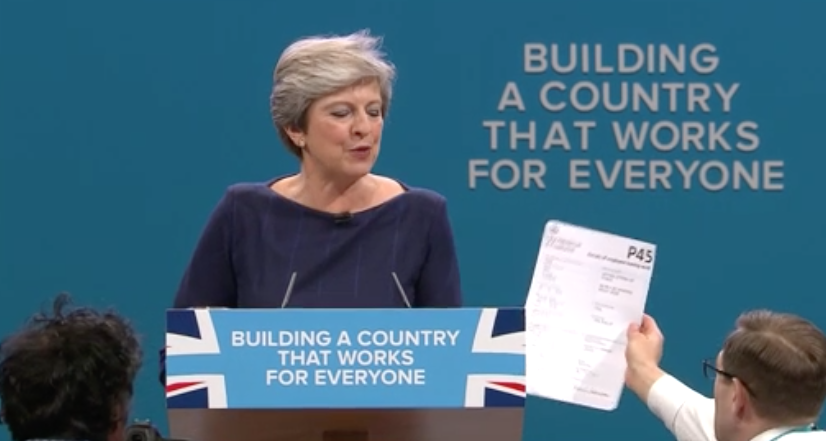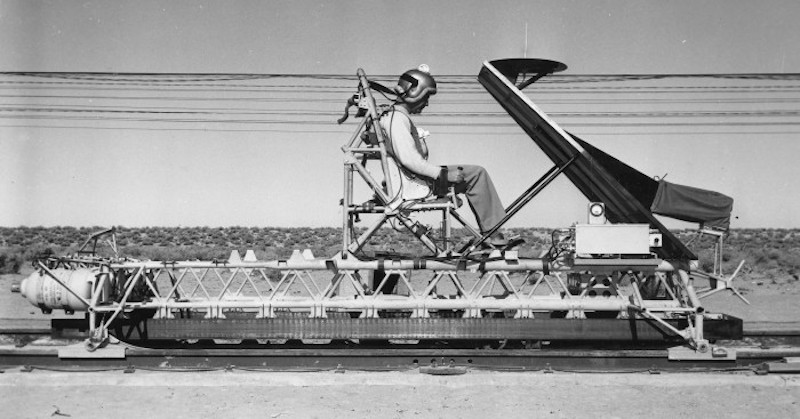
Hecklers and heckling can be a headache for public speakers – just ask Theresa May whose keynote speech was ruined by a prankster with a P45 (and one or two other glitches)!
So how should she, and more importantly we who earn a living giving presentations, deal with such unwelcome interruptions? By their very nature the specifics of a heckle are hard to anticipate and plan for, let alone rehearse. But there is a generic approach that can work in a variety of different situations. I call it my stop the sslandder technique.
You’ll notice I’ve spellled sslandderr in a slightly unconventional way (and I had to disable auto-correct to do so). It’s because the letters of the word stand for the steps you can take as a speaker to keep heckles down without getting your hackles up. And also because hecklers often do come up with, if not slanders, then certainly slurs. So here are the steps:
- Stop
- Smile
- Listen
- Acknowledge
- Negotiate
- Deal
- Delay
- Eject
- Re-start
- Repeat.
So now let’s take them one-by-one…
Stop
So you’re still speaking but that reptilian bit of your mind that’s always working even when your lips are moving has registered an unwelcome sound somewhere in that sea of faces that is the audience. It’s not yet the full-throated roar of an angry lion but nor is it the polite sneeze of a timid mouse. Question is do you stop or press on?
For the “harrumphers” in the audience – that is those who exhibit what I call sub-heckling behaviour – ignoring these minor interupptions may just work. Trouble is that the harrumph could be the precursor to a louder and more persistent interruption. So if the noises off are minor and they do quieten down quickly continuing is fine. But if the initial noises are major or the volume rapidly increases then my advice is to seize the initiative and stop. Show you’re in control of your mouth and manners even if, and especially as, they (the hecklers) are not. The alternative is worse: you keep going so they get louder; you get louder to make yourself heard above the din so they get louder still… If this was an arms race you’d be heading for mutually assured destruction. Mad. So stop before you’re forced to. On your terms not theirs. Look strong. Not weak.
In any case if two or more people are talking at once nobody’s going to hear you properly. At the very least the audience will be distracted. And a distracted audience is harder to “sell” to.
Smile
You probably won’t be smiling on the inside with that carefully crafted speech in tatters at your feet instead of the roses of adulation you’d been hoping for. But hang on! It hasn’t been ruined – yet. So relax. Take a deep breath. And smile. Force that smile if necessary and you’ll find that it soon turns into a more natural version. At the very least it shows good grace and coolness under fire. At best a smile can be disarming as well as charming and simply showing your teeth (it’s an ape thing) can be enough to subdue the hecklers. But even if it doesn’t it’s likely to win you a bit of audience sympathy. And you need the audience on your side for the subsequent steps. Otherwise it’s just you versus the heckler and what if they’re bigger than you, or uglier than you, or both? Besides the heckle may actually have been funny so smile, join in the laughter – even if it’s at your own expense. Nothing like a bit of self-deprecation to win even more audience support.

Listen
Hecklers want to be heard. That’s why they heckle in the first place. So listen to them. And listen carefully with all the active listening skills you can muster (a look of concern on your brow, your best ear pointing their way, your head tilted slightly to one side). Try to ignore the anger – the heat if you will – and see the point they’re trying to make, however angrily or illogically – the light. The listen can in itself be disarming. Coupled with the smile before it, listening can be twice as effective. Better still link both with the next move…
Take our presentation skills survey to find out what kind of presenter you are.
Acknowledge
It’s easy to allow an argument to be defined by the differences between two sides (you and the heckler in this case). After all that’s how arguments start in the first place. But what if you could redefine the fight the heckler’s picking by concentrating on the points you agree on? You’re not going to lose the argument by acknowledging their anger. You’re not going to lose by conceding some neutral or indefensible ground. “I can see you’re angry. I can hear the passion in your voice. We welcome passionate people.” I’m paraphrasing but these are the sorts of things that the former US President, Barack Obama, said to soothe tempers when he was heckled. “You’re absolutely right, politicians – me included – must do more to help the poor, the downtrodden, the neglected (delete as applicable). That’s why I got into politics in the first place.” In other words he’s saying – and you need to say to the heckler, “I’m on your side.” And when you’re standing if not literally then metaphorically on common ground there’s no need to shout across the gulf of your differences which is a crucial starting point for the next step…
Negotiate
Clearly you don’t want to spend more than a few minutes of your precious stage time negotiating with a heckler. But demonstrating both your willingness to negotiate and your negotiation skills can, like the preceding steps, enhance your overall credentials and win audience support. As in any negotiation make a reasonable offer, be prepared for a counter offer, amend your original offer in response to the counter offer if it’s reasonable and then stick to it. The whole point of negotiating is, of course, to reach a deal which brings us neatly to our next step…
Deal
There are two types of deal: the deal that gives the heckler what they want, or enough of what they want, to shut them up permanently; and the deal that silences them temporarily – at least until you’ve swept magisterially from the podium with those bouquets strewn in your path. If you’ve listened carefully and understood enough of what they want, maybe you can do a deal there and then. Perhaps they feel their voice hasn’t been properly heard, in which case don’t eject them from the hall, as this will only exacerbate the problem from their perspective. Invite them to a seat closer to you. Move closer to them. The closer physical proximity can demonstrate a willingness to closer intellectual proximity. It also plays to the old adage keep your friends close but your enemies closer.
Delay
If you can’t do a deal (and it’s rarely sensible to do a big deal in the heat of the moment) then try to delay. A dealay, if you’ll forgive me for making up a word, encourages the heckler to think that a bigger deal may be in prospect if only they wai. It can buy you time. Offer to meet them afterwards for some “quality face time” as one person I heard put it inelegantly but effectively. And because the art of the deal is to get something in return you might try making their part of the deal more explicit as in: “How about you and I get together one-to-one at the end of my speech and in return you and I stop discussing this right now in front of these patient people so that they can hear the rest of what they came for?”
Eject
You’ll understand why I’m not offering the above advice on a money-back-if-not-completely-satisfied basis. The most determined and disruptive hecklers can’t be simply silenced rather they simply can’t be silenced. In which case we’re up to E for eject in our ten point plan for dealing with hecklers. If there are heaps of hecklers it may be best for you to pull the eject handle and make a steady (never rush) exit from the podium with as much of your dignity in tact as possible. But like a fighter pilot ejecting from a jet, this should be a last resort.
In most cases it’s better to eject the heckler, although again with as much dignity as possible. Give them every opportunity to leave under their own steam with perhaps a gentle guiding hand on the small of their back from a well-mannered colleague or security guard (if it’s that kind of event and you’re that kind of person). It never looks good to see people – even hecklers – manhandled from a venue. It may play well with the audience with you in the venue who have seen the wider context and your valiant efforts to not reach this point. But how will it appear to the wider audience watching on television or on the web (again if it’s that kind of event) where the context is lost. If the archetype you’re trying to establish and/or reinforce for you and your organisation is say the care-giver then the subliminal message of a person being wrestled, kicking and screaming, from your presentation is working against you. This is why Obama did his level best not to get to the eject step. Trump, on the other hand, wants to convey the strong man archetype -a bit like the bear-wrestling, torso-baring Putin. So they and maybe you actively relish this step, witness Trump calling for a heckler to be “taken out and beaten up and I mean that seriously.” You can compare and contrast Trump and Obama’s differing styles on this fascinating Huffington Post video.
Restart
In most cases you’ll be able to restart without a messy ejection. If you can’t remember where you left off ask the audience: “Now where were we?” Note that’s where were we not where was I. The heckle is a collective inconvenience shared by everyone not just you. This approach shows you care for your audience and along with all that compassion you showed the heckler (unless you’re in the Trump school) will send your ratings soaring. But before you get carried away and start thinking of those garlands all over again a word of warning…
Repeat
Unless all of the hecklers have been ejected from the venue and unless those who’ve been persuaded to shut up and stay keep their word, then you may have to repeat all or some of these steps. Stop again and smile winningly. Listen carefully. Acknowledge what it’s reasonable to acknowledge – if only their anger. Negotiate again (gently chiding them from breaking the last deal you brokered). Reach a new deal. Delay the resolution if you can’t find a solution there and then. Eject them this time (assuming you didn’t last time and they snuck back in when nobody was watching). Restart and, all being well, this time you won’t need to repeat step ten.
Richard Uridge runs presentation and public speaking skills courses for a wide range of clients – particularly in the not-for-profit sector. He must be a masochist because he actually enjoys the thrill of dealing with hecklers. So if you’d like to book a place on one of his workshops and heckle him he’d be delighted – especially as you’ll be paying modestly (from just £99 per person) for the privilege.
Like this:
Like Loading...
 Answering a journalist’s question is all very well when it’s a helpful question. But if it’s unhelpful, unanswerable or unwelcome, responding is often better than actually answering – providing you don’t sound evasive, ignorant or both. So in this short talk our lead media trainer, Richard Uridge, show you how to switch your interviews from a question and answer template to a question and response approach.
Answering a journalist’s question is all very well when it’s a helpful question. But if it’s unhelpful, unanswerable or unwelcome, responding is often better than actually answering – providing you don’t sound evasive, ignorant or both. So in this short talk our lead media trainer, Richard Uridge, show you how to switch your interviews from a question and answer template to a question and response approach.
 How to hook your audience at the start of your presentation by zooming in on a detail. It’s better, says ACM Training’s presentation skills coach, Richard Uridge, than overwhelming them with the “big picture.” Or boring them with something that looks and sounds the same as every other presentation they’ve ever seen.
How to hook your audience at the start of your presentation by zooming in on a detail. It’s better, says ACM Training’s presentation skills coach, Richard Uridge, than overwhelming them with the “big picture.” Or boring them with something that looks and sounds the same as every other presentation they’ve ever seen.








